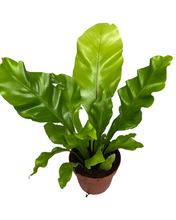Asplenium nidus is an epiphytic fern and part of the Aspleniaceae family. Its native range is Malesia to N. & NE. Queensland, it is often called 'Birds nest fern'. Fronds are strap shaped and shiny, bright green with dark brown midribs. The fronds grow in an inverted cone shape, there is a nest-like centre (hence the name) that collects falling debris. Sporangia forms in clusters on the undersides of fronds.
The genus Asplenium etymology is from the New Latin for ‘spleenworts’ and the specific epithet nidus is from the Latin for nest.
For more information on Epiphytes, read our blog here.
Light: Bright indirect light, meaning the plant sees the sun for 0-4 hours per day - this could be through trees or a translucent curtain, it’s important for the plant to see the sky in order to thrive.
Water: Asplenium nidus prefer their substrate to be consistently moist, allow the top inch of the mix to dry out. Pour water slowly over the top of the substrate and allow the water to pass through the drainage holes; avoid pouring water into the heart of the plant.
Potting mix: A rich well draining mix composed of coco coir, perlite or vermiculite, a little bit of orchid bark and worm castings. These plants only have shallow root systems so it is important to keep the rhizomes at the substrate surface.
Fertilising: Feed your plant every few waterings during the growing season or when you observe active growth. You can dilute fertiliser to half the recommended amount but never add more.
Temperature: Ideally 18-28°C, no cooler than 15°C.
Humidity: Asplenium would prefer higher humidity. You can increase humidity by placing the plant on a watered pebble tray or using a humidifier.
Asplenium are non-toxic.





